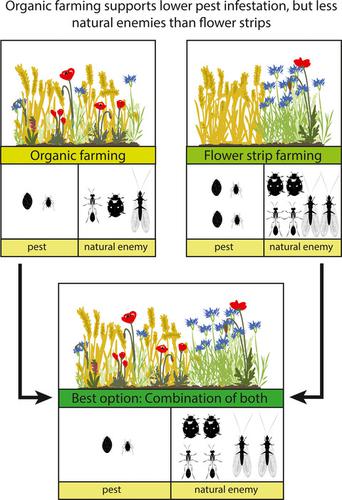当前位置:
X-MOL 学术
›
J. Appl. Ecol.
›
论文详情
Our official English website, www.x-mol.net, welcomes your
feedback! (Note: you will need to create a separate account there.)
Organic farming supports lower pest infestation, but fewer natural enemies than flower strips
Journal of Applied Ecology ( IF 5.0 ) Pub Date : 2021-06-10 , DOI: 10.1111/1365-2664.13946 Edina Török 1 , Sinja Zieger 2 , Jacob Rosenthal 2 , Rita Földesi 2, 3 , Róbert Gallé 1 , Teja Tscharntke 2 , Péter Batáry 1, 2
中文翻译:

有机农业支持较低的害虫侵袭,但天敌比花条少
更新日期:2021-06-10
Journal of Applied Ecology ( IF 5.0 ) Pub Date : 2021-06-10 , DOI: 10.1111/1365-2664.13946 Edina Török 1 , Sinja Zieger 2 , Jacob Rosenthal 2 , Rita Földesi 2, 3 , Róbert Gallé 1 , Teja Tscharntke 2 , Péter Batáry 1, 2
Affiliation

|
- Agricultural intensification has led to dramatic losses of species and associated ecosystem services. In the European Union, agri-environment schemes (AESs) have been developed to mitigate these challenges. There are two opposing AES strategies, targeting either production or non-production areas. Organic farming focuses on production and conservation on the same land-use area, whereas flower strips adjacent to crop fields are in favour of intensified conventional production combined with conservation strips outside the cultivated area.
- We investigated pest and natural enemy abundances of organic farming versus establishing flower strip in 10 agricultural landscapes in Central Germany along a gradient of mean field size (1.24–6.78 ha). We focused on three winter wheat fields per landscape: conventional field (control), conventional field with adjacent flower strip and organic field. We sampled crop pests such as cereal leaf beetles (CLBs) and cereal aphids as well as their natural enemies.
- Our results indicated that the abundance of CLB larvae was more than two times higher in conventional farming with and without flower strip than that in the organic farming. The abundance of natural enemies was supported by landscapes with small mean field size, that is their numbers increased c. threefold when field size decreased from 7 to 2 ha.
- Aphid abundance was lower in organic fields and conventional control fields than in conventional fields with flower strips suggesting a potential disservice of flower strips. Parasitoids and natural enemies benefited from flower strips, but they were obviously not able to control the aphids.
- Synthesis and applications. The major pests in cereals, aphids and CLBs infested organic farming less than flower strips along conventional fields. However, the abundance of natural enemies of pests benefited from flower strips and, in addition, from decreasing field size in agricultural landscapes. Hence, enhancing predator populations for more effective biological pest control may be best with decreasing field sizes combined with organic farming and flower strips. Altogether, organic farming might contribute much more to low pest damage than a conventional farming strategy with flower strips.
中文翻译:

有机农业支持较低的害虫侵袭,但天敌比花条少
- 农业集约化导致物种和相关生态系统服务急剧减少。在欧盟,已经制定了农业环境计划 (AES) 来缓解这些挑战。有两种相反的 AES 策略,针对生产或非生产区域。有机农业侧重于同一土地利用区域的生产和保护,而靠近农田的花带则有利于集约化常规生产与耕地外的保护带相结合。
- 我们沿着平均田地面积(1.24-6.78 公顷)的梯度调查了德国中部 10 个农业景观中有机农业的害虫和天敌丰度与建立花卉带。我们专注于每个景观的三个冬小麦田:常规田(对照)、带有相邻花带的常规田和有机田。我们对谷物叶甲虫 (CLB) 和谷物蚜虫等作物害虫及其天敌进行了采样。
- 我们的结果表明,在有和没有花条的常规农业中,CLB 幼虫的丰度是有机农业的两倍多。天敌的丰富性得到了平均田地面积较小的景观的支持,即它们的数量增加了c。当田地面积从 7 公顷减少到 2 公顷时,增加了三倍。
- 有机田和常规对照田的蚜虫丰度低于带有花条的常规田地,这表明对花条的潜在危害。寄生蜂和天敌从花条中获益,但它们显然无法控制蚜虫。
- 合成与应用。谷物、蚜虫和 CLB 中的主要害虫在有机农业中的侵染少于常规田地的花条。然而,大量的害虫天敌受益于花条,此外,农业景观中田地面积的减少。因此,增加捕食者种群以进行更有效的生物害虫控制可能是最好的方法,即减少田地面积并结合有机耕作和花条。总而言之,与使用花条的传统耕作策略相比,有机耕作对降低害虫危害的贡献更大。











































 京公网安备 11010802027423号
京公网安备 11010802027423号